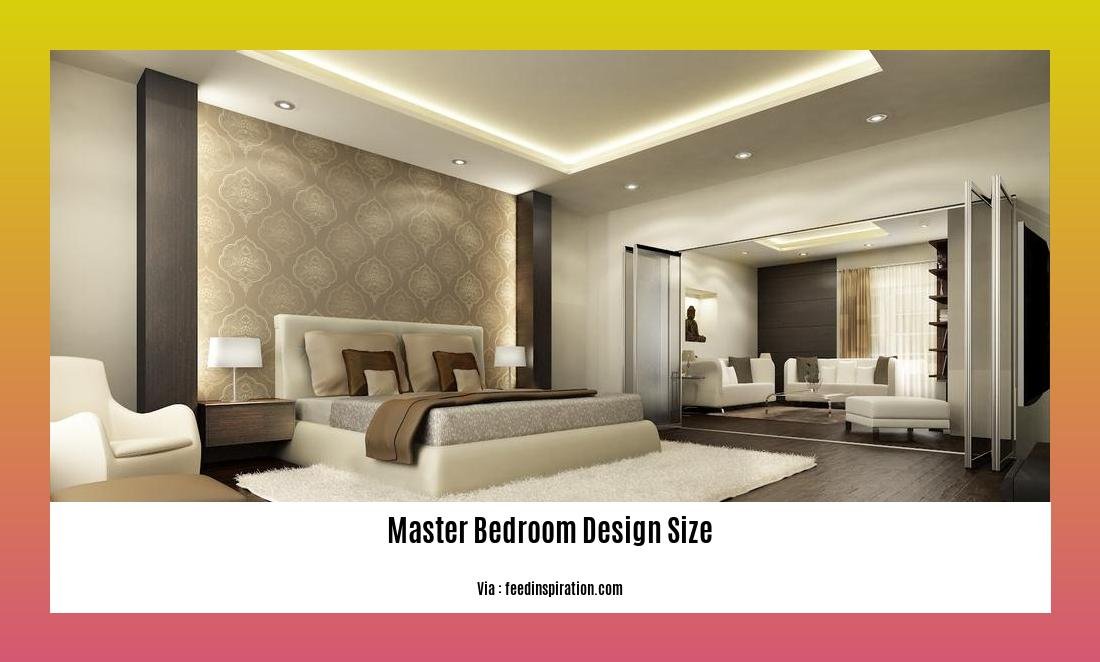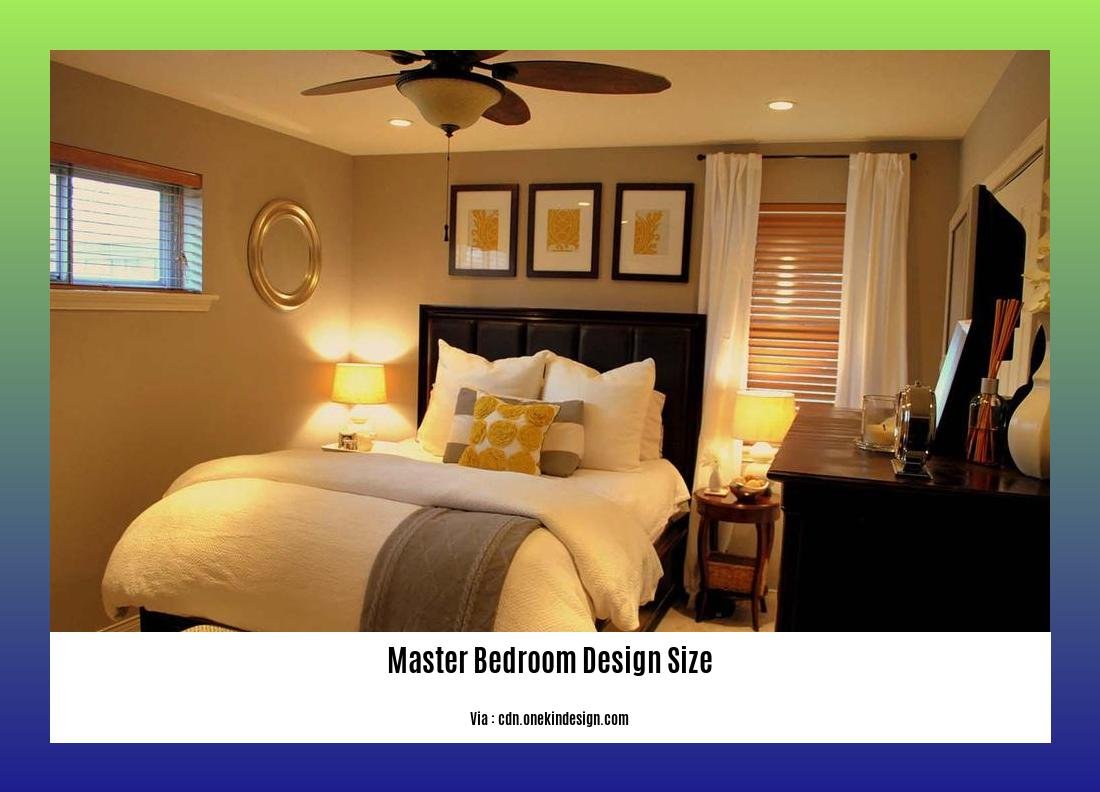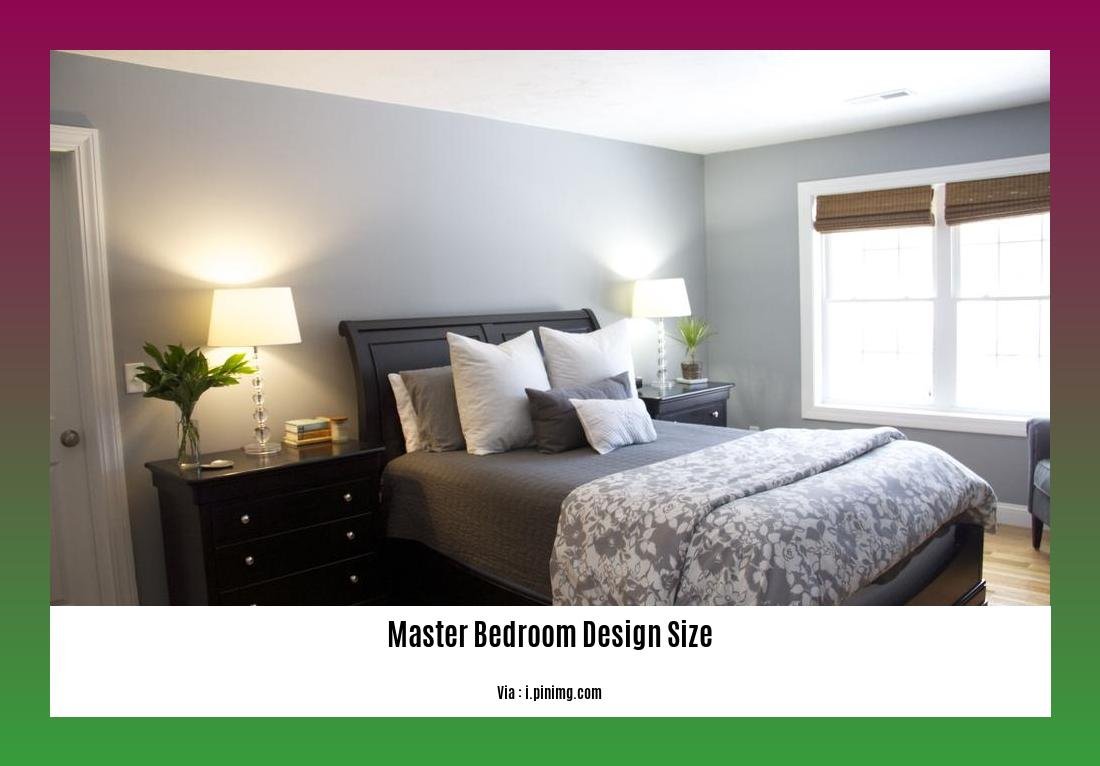Creating a master bedroom that exudes harmony and functionality is essential for anyone seeking a peaceful sanctuary within their home. The optimal master bedroom design size plays a crucial role in achieving this ideal balance. As experienced interior designers specializing in luxury residential projects, we understand the importance of spatial planning and the impact it has on comfort and elegance. In this article, we will explore the key factors that contribute to creating harmonious and functional spaces in master bedrooms, ensuring they are tailored to individual preferences and lifestyle needs.
Key Takeaways:
- The standard size of a master bedroom is approximately 225 square feet or 15 by 15 feet.
- The size of a master bedroom can vary based on the overall size of the house.
- Master bedrooms in houses that are more than 3,000 square feet can range from 16 x 22, 18 x 20, 18 x 22, 20 x 20, or 350 to 420 square feet.
- For houses measuring more than 279 square meters, the master bedroom size can be 4.8 x 6.7, 5.4 x 6, 5.4 x 6.7, 6 x 6, or 33 to 39 square meters.
Master Bedroom Design Size

Are you looking to create a harmonious and functional master bedroom? One key aspect to consider is the size of the room. The size of a master bedroom can greatly impact its overall design and functionality. In this article, we will explore the optimal master bedroom design size and provide tips on creating a space that maximizes comfort and elegance.
Understanding the Standard Size
The standard size of a master bedroom is around 225 square feet or approximately 15 by 15 feet. This size provides enough space for essential furniture and allows for comfortable movement within the room. However, it’s important to note that the size of a master bedroom can vary depending on the overall size of the house. For larger homes measuring over 3,000 square feet or 279 square meters, the master bedroom size can be expanded to 16 x 22, 18 x 20, 18 x 22, 20 x 20, or even 350 to 420 square feet (4.8 x 6.7, 5.4 x 6, 5.4 x 6.7, 6 x 6, or 33 to 39 square meters) to accommodate the additional space.
Maximizing Space and Functionality
When designing a master bedroom, it’s important to consider the overall functionality and use of the space. Here are some tips to help you make the most out of your master bedroom design:
-
Plan for Adequate Circulation: Ensure that there is enough space for easy movement within the room. Avoid cluttering the room with unnecessary furniture or accessories that may impede circulation.
-
Consider Furniture Placement: Arrange furniture strategically to optimize space. Place the bed against a wall to create a focal point and free up floor space. Utilize corner areas for storage or additional seating options.
-
Opt for Built-In Storage Solutions: Incorporate built-in storage solutions like closets, cabinets, or shelving units to maximize storage space and keep the room organized.
-
Choose Multi-Functional Furniture: Select furniture pieces that serve multiple purposes, such as an ottoman with hidden storage or a bedside table with drawers. This allows you to make the most of the available space without sacrificing functionality.
-
Utilize Vertical Space: Take advantage of vertical space by incorporating tall furniture pieces like wardrobes or armoires. This helps to minimize clutter and provides additional storage options.
-
Consider Lighting: Ensure proper lighting in the bedroom to create an ambiance that is both functional and inviting. Incorporate a combination of overhead lighting, task lighting, and ambient lighting to achieve the desired effect.
By implementing these design strategies, you can create a master bedroom that not only looks visually appealing but also offers ample space and functionality.
The Power of Proportions
When it comes to designing a master bedroom, proportions play a crucial role in creating a harmonious space. Although the size of the room is important, it’s equally essential to consider the scale and proportions of the furniture and decor elements within the space. Here are some key points to keep in mind:
-
Balance is Key: Achieve a sense of balance within the room by carefully selecting furniture and decor elements that complement each other in terms of size and scale. Avoid overcrowding the room with oversized pieces or placing smaller items that get lost in the overall design.
-
Visual Weight: Consider the visual weight of each element in the room. Balance heavier pieces with lighter ones to create a harmonious composition that is visually pleasing.
-
Symmetry vs. Asymmetry: Decide on whether you prefer a symmetrical or asymmetrical design approach. Symmetry provides a sense of stability and order, while asymmetry adds a touch of visual interest and uniqueness.
-
Embrace Contrast: Add visual interest to the room by incorporating contrasting elements such as light and dark hues, smooth and textured surfaces, or modern and traditional styles. This adds depth and dimension to the overall design.
By paying attention to proportions and creating a well-balanced design, you can transform your master bedroom into a personalized sanctuary that exudes elegance and functionality.
Incorporating Personal Style
While it’s important to consider the optimal size and proportions of a master bedroom, it’s equally crucial to infuse your personal style and preferences into the design. Your master bedroom should be a reflection of your individual taste and lifestyle. Consider the following tips to create a personalized space:
-
Choose a Color Scheme: Select a color palette that resonates with your personal style and creates a soothing ambiance. Whether you prefer calming neutrals, bold hues, or a combination of shades, use colors to create a cohesive and inviting atmosphere.
-
Add Personal Touches: Incorporate personal mementos, artwork, or decorative pieces that hold sentimental value. These additions make the space feel more personal and reflect your unique personality.
-
Consider Texture and Materials: Experiment with different textures and materials to add depth and visual interest to the room. Whether it’s a plush rug, cozy throw pillows, or luxurious bedding, these elements enhance the overall ambiance and comfort of the space.
-
Don’t Forget About Comfort: Ultimately, your master bedroom should be a comfortable sanctuary where you can relax and unwind. Invest in a quality mattress, pillows, and bedding to ensure a good night’s sleep. Create cozy seating areas for lounging or reading, and incorporate soft, ambient lighting to set a calming mood.
Remember, designing a master bedroom is all about creating a space that aligns with your lifestyle and makes you feel at ease.
In conclusion, the optimal size and design of a master bedroom greatly impact its overall functionality and appeal. By considering the standard size, maximizing space and functionality, paying attention to proportions, and incorporating personal style, you can create a master bedroom design that is both harmonious and functional. Remember to prioritize your comfort and individual preferences when crafting your ideal sanctuary.
If you’re looking for fitted bedroom furniture suppliers near you, look no further! Check out our selection of high-quality fitted bedroom furniture from suppliers near you. Click here to browse.
Curious about how many recessed lights you should have in your bedroom? Find out the answer to this question and more by clicking here.
Are you wondering about the dimensions of a master bedroom? Look no further! Click here to find the information you need.
Looking for the best mattress deals in Lahore? Check out our competitive prices on mattresses here.
The Role of Furniture Placement in Maximizing Space and Functionality

When it comes to designing a master bedroom, furniture placement plays a vital role in maximizing space and functionality. By strategically arranging furniture and utilizing space-saving solutions, you can create a harmonious and practical living environment. Let’s explore some key considerations and tips for optimizing your master bedroom design.
Creating Openness and Flow
One effective strategy for maximizing space in a master bedroom is to create an open layout. By pushing furniture against the walls and creating clear pathways, you can open up the room and enhance traffic flow. For example, consider placing the bed against one wall and leaving enough space for easy movement around it. This simple adjustment can make the room feel more spacious and functional.
Utilizing Vertical Space
In addition to furniture placement, utilizing vertical space is crucial for maximizing room functionality. Installing shelves or hanging artwork not only adds visual appeal but also provides efficient storage solutions. These vertical elements draw the eye upward, creating an illusion of height and making the room feel larger. Consider incorporating shelving units or wall-mounted storage to keep items organized and free up valuable floor space.
Functionality and Purpose
When selecting furniture for your master bedroom, it’s important to prioritize functionality and purpose. Each piece of furniture should serve a specific function and contribute to the overall functionality of the space. For example, a bed should provide a comfortable place to sleep, while a desk can serve as a workstation. By carefully considering the purpose of each item, you can ensure that your furniture enhances the functionality of the room.
Finding the Right Balance
When arranging furniture, finding the right balance is key. Consider the proportions, visual weight, and symmetry or asymmetry of the room. A well-balanced space creates a harmonious and visually pleasing environment. For example, if you have a large bed, balance it out with smaller bedside tables or lamps. Embrace contrast by mixing textures, materials, or colors to add visual interest and depth to the room.
Personalization and Comfort
Lastly, don’t forget to infuse your personal style and prioritize comfort in your master bedroom design. Choose a color scheme that reflects your taste and creates a calming ambiance. Incorporate personal touches such as artwork, photographs, or meaningful decor items to make the space uniquely yours. Consider using soft and cozy materials for bedding and seating to enhance comfort and create a welcoming atmosphere.
Key Takeaways:
- Strategic furniture placement can maximize space and functionality in a master bedroom.
- Creating an open layout and clear pathways enhances traffic flow and makes the room feel more spacious.
- Utilize vertical space with shelves and wall-mounted storage solutions to keep the floor clear and make the room appear larger.
- Prioritize the functionality and purpose of each piece of furniture in the room.
- Find the right balance in proportions, visual weight, and symmetry vs. asymmetry for a harmonious and visually pleasing space.
- Infuse your personal style and prioritize comfort to create a bedroom that reflects your taste and provides a relaxing sanctuary.
Sources:
– Coohom: The Art of Furniture Placement: Maximizing Space and Functionality
– The Designeur: Functional Interior Design – Definition and Benefits
Tips for Designing a Master Bedroom that Suits Individual Preferences and Lifestyle Needs
When it comes to designing a master bedroom that perfectly suits your individual preferences and lifestyle needs, there are several key factors to consider. By following these tips, you can create a harmonious and functional space that reflects your personal style and enhances your daily life.
Start with the dimensions of your bedroom
Before diving into the design process, it’s crucial to understand the dimensions of your bedroom. Take accurate measurements to ensure that your furniture and other elements fit properly. This will help you avoid overcrowding or creating a space that feels cramped. By knowing the size of your bedroom, you can plan for the right furniture pieces and ensure easy movement around the room.
Consider the average size of a bedroom
While the average bedroom size in the US is about 132 square feet, it’s important to remember that individual preferences and lifestyle needs can vary. This average size can serve as a useful reference point, but feel free to adjust according to your specific requirements. If you desire more space for a larger bed or additional furniture, consider expanding the size of your master bedroom.
Evaluate architectural elements and personalize the layout
When planning your master bedroom layout, take into account the existing architectural elements, such as windows, doors, closets, and ceiling elements. Incorporate these features into the design to add character and functionality to your space. Additionally, personalize the layout by considering how you will use the room. Whether it’s incorporating a workspace or creating a cozy reading nook, tailor the design to suit your lifestyle.
Optimize furniture choices and placement
Choosing the right furniture is crucial for designing a master bedroom that suits your preferences and lifestyle needs. Consider incorporating furniture essentials like a comfortable bed, nightstands for convenience, and storage solutions to keep the room organized. When it comes to furniture placement, ensure that it maximizes space and functionality. For example, position the bed to allow for easy movement and create a focal point that aligns with your desired view.
Select the perfect color scheme and personalize with decor
The color scheme you choose can significantly impact the overall ambiance of your master bedroom. Consider the mood you want to create and select colors that evoke that feeling. Opt for soothing shades like blues or pastels for a calm and relaxing atmosphere. To personalize the space further, incorporate decor elements that reflect your personality, such as artwork, photographs, or sentimental items. These personal touches will make your master bedroom feel truly yours.
Don’t forget about storage and organization
Adequate storage is essential for maintaining a clean and clutter-free master bedroom. Incorporate built-in wardrobes, dressers, or shelving units to maximize storage space. Plan for storage solutions that suit your specific needs, whether it’s a shoe rack, jewelry organizer, or a dedicated space for accessories. Prioritizing storage will help keep your master bedroom tidy and enhance its functionality.
Ensure proper lighting and ventilation
Lighting and ventilation play a crucial role in creating a comfortable and inviting master bedroom. Consider both natural and artificial lighting sources to ensure a well-lit space that suits your preferences. Install a combination of ambient, task, and accent lighting to cater to different activities and moods. Additionally, proper ventilation is essential for maintaining a fresh and pleasant atmosphere. Windows, fans, or air purifiers can help ensure good air circulation in your master bedroom.
Seek inspiration and stay up-to-date with trends
Stay inspired and informed about the latest trends and innovations in master bedroom design. Browse through magazines, websites, and social media platforms to gather ideas and discover new styles that resonate with you. Keeping up with trends can help you create a master bedroom that feels contemporary and on-trend while still reflecting your personal preferences.
Find the perfect balance between aesthetics and functionality
As you design your master bedroom, remember to strike a balance between aesthetics and functionality. It’s important to create a space that not only looks beautiful but also meets your everyday needs. Consider the practicalities of your lifestyle and incorporate elements that enhance your daily routine. Whether it’s adding a seating area for relaxation or a designated workspace, ensure that every design choice serves a purpose and contributes to the overall functionality of the room.
Key Takeaways:
- Start by considering the dimensions of your bedroom to ensure furniture fits properly.
- Personalize the layout by incorporating architectural elements and catering to your specific lifestyle needs.
- Optimize furniture choices and placement to maximize space and functionality.
- Select a color scheme that suits your desired mood and personalize the space with decor elements.
- Prioritize storage and organization to keep your master bedroom tidy and clutter-free.
- Ensure proper lighting and ventilation for a comfortable and inviting atmosphere.
- Seek inspiration and stay up-to-date with the latest trends in master bedroom design.
- Strive for a balance between aesthetics and functionality, creating a space that looks beautiful and meets your everyday needs.
Sources:
1. Livspace. Master Bedroom Design | A Guide to Design the Main Bedroom.
2. Bored Panda. Master Bedroom Ideas: 59 Ways to Design Your Place.
Exploring Innovative Design Ideas to Make the Most of Limited Space in Smaller Master Bedrooms
When it comes to designing smaller master bedrooms, innovative ideas are essential to maximize space while maintaining style and functionality. With a few strategic design choices and creative solutions, compact spaces can be transformed into stylish and functional sanctuaries that make the most of every inch. In this article, we will explore innovative design ideas that can help you optimize limited space in smaller master bedrooms.
Key Takeaways:
- Minimalist design and clutter reduction are key strategies for maximizing space in smaller master bedrooms.
- Furniture with built-in storage and creative use of unused spaces can help maximize storage options and free up floor space.
- Optimal lighting choices can enhance the perception of space, create ambiance, and maximize functionality.
- Strategic placement of the bed can serve as the focal point of the room and help optimize space utilization.
- Utilizing architectural features, such as alcoves or sloped ceilings, can provide opportunities for additional storage or functional areas.
Harnessing the Power of Minimalism
When working with limited space, embracing a minimalist design approach is key. By carefully curating furniture and decor, you can create a sense of openness and maximize the available space. Keep the color palette simple and light, as it can make the room feel more spacious. Consider opting for clean lines and simple designs in furniture to maintain a streamlined look.
Embracing Furniture with Built-in Storage
In smaller master bedrooms, every inch of space counts. Choosing furniture pieces with built-in storage can help you maximize functionality without sacrificing style. Look for beds with drawers underneath, nightstands with shelves or compartments, and ottomans that can double as storage. These clever design solutions provide abundant storage options while keeping the room clutter-free.
Creative Use of Unused Spaces
Innovative design ideas can help you make the most of unused spaces in smaller master bedrooms. Consider utilizing vertical space by installing floating shelves or wall-mounted cabinets. These can provide additional storage for books, decor, or even everyday essentials. Additionally, transforming unused corners into cozy reading nooks or small workstations can optimize the functionality of the room.
The Power of Lighting
Lighting plays a crucial role in any room design, and smaller master bedrooms are no exception. By strategically placing different light sources, you can create an illusion of space and enhance the overall ambiance. Incorporate a mix of overhead lighting, task lighting, and accent lighting to maximize functionality and create a warm and inviting atmosphere.
Making the Bed the Focal Point
In smaller master bedrooms, it is essential to make the bed the focal point of the room. Positioning the bed against a wall or in a corner can free up valuable floor space and create a sense of openness. Consider placing a striking headboard or artwork above the bed to draw the eye and make a statement.
Utilizing Architectural Features
Architectural features can offer unique opportunities to maximize space in smaller master bedrooms. Alcoves or recessed areas can be transformed into functional spaces, such as built-in desks or cozy seating areas. Sloped ceilings can be utilized for storage or created into charming reading nooks. By embracing these architectural elements, you can make the most of the available space while adding character to the room.
Conclusion
Innovative design ideas are essential when it comes to making the most of limited space in smaller master bedrooms. By adopting a minimalist approach, embracing furniture with built-in storage, creatively utilizing unused spaces, optimizing lighting choices, making the bed the focal point, and utilizing architectural features, you can create stylish and functional sanctuaries that maximize every inch of space. With these innovative design ideas, you can transform your smaller master bedroom into a harmonious and efficient retreat.
Sources:
- Spark & Chemistry: 10 Smart Design Solutions for Small Bedrooms
- Narrow House Tips: Small Master Bedroom Ideas and Tips
FAQ
Q1: What is the standard size for a master bedroom?
A1: The standard size of a master bedroom is around 225 square feet or about 15 by 15 feet.
Q2: Does the size of a master bedroom vary depending on the size of the house?
A2: Yes, the size of a master bedroom can vary depending on the size of the house. For houses measuring more than 3,000 square feet, the master bedroom size can be 16 x 22, 18 x 20, 18 x 22, 20 x 20, or 350 to 420 square feet.
Q3: What are the dimensions of a master bedroom in square meters?
A3: For houses measuring more than 279 square meters, the master bedroom size can be 4.8 x 6.7, 5.4 x 6, 5.4 x 6.7, 6 x 6, or 33 to 39 square meters.
Q4: How can I maximize space and functionality in a small master bedroom?
A4: To maximize space and functionality in a small master bedroom, you can use space-saving furniture, arrange furniture to create an open layout, utilize vertical space with shelves and artwork, and ensure that each piece of furniture serves a specific function.
Q5: What are some tips for planning a bedroom layout?
A5: When planning a bedroom layout, consider the dimensions of your bedroom, evaluate the architectural elements, think about how you will use the room, consider the view, include furniture essentials, choose the right colors, prioritize storage, and personalize the space with decor elements.
- How to Get Rid of Mushrooms in Your Lawn: A Complete Guide - April 24, 2025
- How to Get Rid of Ground Hornets: A Safe and Effective Guide to Eliminating Nests - April 24, 2025
- How to Get Rid of German Roaches Fast: DIY Methods for Quick Control - April 24, 2025










